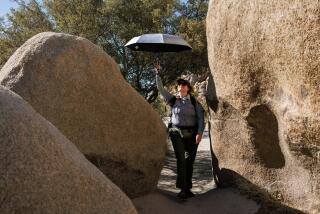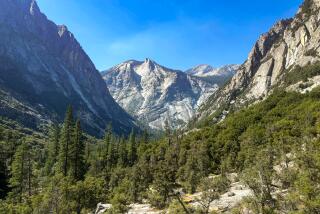Anchorage’s Outback
- Share via
ANCHORAGE, Alaska — On a Friday evening in late spring, the sun was still high, promising enough daylight hours for me to unwind in Chugach State Park, the “accessible wilderness” that borders the east side of this city. After only a 30-minute drive from my home downtown and a 45-minute hike up the park’s Flattop Mountain, I gazed out across hundreds of square miles of south-central Alaska, from the 20,320-foot Denali (also known as Mt. McKinley) to the north to the Cook Inlet at my feet.
In a state with 19 peaks above 14,000 feet and 17 of the nation’s 20 highest mountains, Flattop is a mere bump at 3,550 feet. But this sawed-off mountain has an extraordinary allure for us locals. Less than 15 miles from downtown and visible throughout the city, Flattop is easy to find, easy to reach and, as mountains go, easy to climb. From the main trail head, it’s only 1 1/2 miles and 1,350 feet in elevation gain to the summit. And in summer no climbing expertise is needed; the ascent is more of a strenuous hike, taking anywhere from 30 minutes to two hours depending on expertise. Some rock scrambling is necessary near the top.
Nearly all of Anchorage’s 250,000 residents, it seems, have climbed Flattop, or at least tried. And enough have succeeded to make it easily the most-climbed mountain in Alaska, as well as one of the principal attractions in Chugach State Park.
Not many non-Alaskans visit the park. It gets barely a mention in mainstream guidebooks. Yet it is an incomparable diversion for people passing through Anchorage en route to popular tourism destinations. It is the perfect place to stretch your legs after a long flight, or while stopping over for a cruise, or before heading into the outback of Denali National Park. Regardless of age and back-country experience, any visitor with access to a car can sample what Chugach has to offer, from high-risk sports such as mountain climbing to leisurely picnicking, berry picking and bird-watching.
The most popular trails start from city streets. There are no roads through the park, but many attractions are along or accessible from the city’s two main highways, Seward and Glenn.
Established in 1970, the state park encloses the western edge of the Chugach Mountains, a 300-mile-long coastal range that arcs from Cook Inlet almost to the Canadian border.
Inside its civilized fringes, the park has 495,000 acres of rugged mountain kingdom, rich with wildlife, jagged rock spires, forested valleys, tundra meadows, alpine lakes and rushing streams fed by dozens of glaciers. Much of this can be seen on marked trails into the interior, but serious outdoors enthusiasts should set aside at least a few days.
The park is home to 2,000 Dall sheep, 500 mountain goats, 400 black bears, 300 moose, 25 grizzlies and at least two wolf packs. Its seasonal inhabitants range from orca whales to tiny brown bats, from 100 species of birds to one amphibian (the wood frog).
Chugach also is prized for its wildflowers. More than 50 species are found in the park, including geraniums, paintbrush, monkshood, bluebells and fireweed.
*
When traffic slows to a standstill on the stretch of Seward Highway that flanks the south side of the park, it’s a good bet the Dall sheep are out. Wild as they are, in summer these snow-white sheep forage all the way down to the road and show no signs of fear even when people come as close as 30 feet.
From April through August, ewes, lambs and young adult rams inhabit the steep cliffs and grassy meadows along the stretch of the highway known as Windy Corner, between Mileposts 106 and 107. Peak viewing occurs in June and early July, shortly after the ewes have given birth. As many as 50 sheep at a time have been spotted from the highway (20 or fewer is closer to the norm). Only rarely will the older, full-curl rams be present; they prefer back-country solitude.
Biologists aren’t sure why the sheep congregate in such large numbers in that spot, but retired state wildlife manager Dave Harkness believes the cliffs above the highway contribute to the animals’ tolerance of human traffic: “The sheep know they have an easy escape route if they need it.”
While Windy Corner’s sheep are guaranteed to draw a crowd, they are not the only major attraction, or even the biggest, along Chugach State Park’s south side, where for 25 miles three key elements intersect: the mountains, Seward Highway and the 40-mile-long estuary called Turnagain Arm. Together they exert a powerful draw.
The ice usually is gone from Turnagain by early May, and the hooligan--oily, smelt-like fish--are back. At Beluga Point (Milepost 110 on Seward Highway), people sit and stare at the thick gray water, looking for signs of the ghostly white beluga whales that often follow the hooligan. Belugas, in turn, are sometimes followed by hunting orcas. The presence of either species is likely to create highway “whale jams” on a par with Windy Corner’s sheep jams.
Depending on the season, people also come to the park to camp, fish for salmon, windsurf Turnagain Arm, hike, climb ice and rocks and watch for North America’s second-largest bore tide (the largest is in Nova Scotia’s Bay of Fundy), a wall of water that can be seen advancing from miles away.
Perhaps the ultimate Chugach wilderness experience is the one related by Cliff Eames, a longtime Anchorage resident. Eames and his backpacking companion Mike Frank were camped on a mountain ridge only 15 miles north of Windy Corner. Shortly before midnight, Eames’ dog, Spike, began to growl. Peering out the tent, the men saw two wolves standing side by side less than 20 feet away.
Eames pulled Spike into the tent, then returned his attention to the wolves. Considerably larger than his 70-pound black Labrador, they had beautiful coats and appeared well-fed. The wolves stared back for perhaps 30 seconds, then turned and walked away. About 75 yards off, they were joined by two other wolves. The foursome howled for 30 to 45 seconds before vanishing into the night.
“The wolves didn’t seem the least bit afraid,” Eames recalled. “And to think we were only an hour from our cars.”
*
Overcast and often drizzly weather is the summer norm in Chugach State Park, so when the sun does shine, crowds of people come out to play, especially on weekends. On a midsummer Sunday afternoon, with the sun shining hotly and daylight lasting more than 19 hours, the Eagle River Nature Center’s parking lot is filled to capacity and people stream in and out of the log building.
Some have questions about trail conditions or the schedule for naturalist programs; others are worried about wildlife.
“There’s so much paranoia about bears,” says seasonal ranger Jill Holdren. “People are constantly asking, ‘Are the bears out today?’ or ‘Any bear attacks today?’ ”
Truth is, black bears are commonly seen along the back-country Crow Pass Trail, but attacks by either black or grizzly bears anywhere in Chugach State Park are extremely rare. During the park’s first 27 years, only two people were killed by a bear, which was defending a moose carcass. (I have seen visitors to the outback ringing cowbells, which supposedly warn bears off. In fact, bears hear the human voice better, especially in dense brush, so rangers recommend talking and singing.)
*
At this latitude, autumn, like spring, is barely noticeable as a transition between seasons. The days shorten rapidly and snow returns. On clear days, the low afternoon sun casts a warm, golden glow on the landscape, but the warmth is an illusion. A cold, biting wind rips down the mountainside, playing with the first snowdrifts, moving them from here to there and back again.
When summer’s crowds have retreated from Flattop’s slopes, the park’s lower elevations remain popular with skiers, snowshoers and snowmobilers. Only those experienced in winter mountaineering explore Flattop’s upper flanks.
A steep gully leads to Flattop’s last 20 to 30 feet, and wind-built snowdrifts accumulate at the top, creating a near-vertical drop-off. It’s not bad when the footing is solid and the snowpack stable, but when the snow is crumbly or a heavy load has been freshly deposited--well, some risks are not worth even the incomparable view from Flattop.
But on a day when the snow is safe and the sky bright, the sight of the city below--looking toy-size for its population of a quarter-million--gives perspective to any problem. When the incessant wind finally cuts through my clothing, I retreat from the edge and Anchorage disappears. All that’s left are the mountains. It is private moments such as these that I count among my happiest. Rejuvenated, I descend.
Sherwonit is the author of “Alaska’s Accessible Wilderness: A Traveler’s Guide to Alaska’s State Parks” (Alaska Northwest Books, Seattle, 1996).
(BEGIN TEXT OF INFOBOX / INFOGRAPHIC)
GUIDEBOOK
Suburban Wilds in Alaska
Getting there: Chugach State Park is a 20- to 40-minute drive from downtown Anchorage or the airport. Several of the most popular trail heads can be reached from city streets, while other trails and park facilities are accessible from Glenn and Seward highways. There are three public campgrounds, all road-accessible.
There are no public roads through the park. Travel is generally by foot in summer and skis in winter, though limited areas are open to bikes, ATVs, horses, motorboats and snowmobiles. Check park regulations for details.
Getting around: Compact car rental rates in peak summer weeks run from $52 (Thrifty, telephone [800] 367-2277) to $59 (Avis, tel. [800] 331-1212) per day plus tax.
When to go: The prime visitor season is June through September, but local residents frequent the park year-round. The best time to see wildflowers is from late June through early August. Birding is best in May and June, berry picking in August and September.
Summers tend to be cool, with daytime temperatures in the 50s and 60s, mostly overcast skies and frequent drizzle.
A list of campgrounds outside the park and companies that offer park tours and guide services is available from park headquarters.
For more information: Chugach State Park headquarters is at Milepost 115 of Seward Highway. Mailing address: HC 52, Box 8999, Indian, AK 99540; tel. (907) 345-5014 (8 a.m.-4:30 p.m., Monday to Friday), fax (907) 345-6982. E-mail: chugstpk@ alaska.net.
Also: Alaska Division of Tourism, P.O. Box 110801, Juneau, AK 99811-0801; tel. (907) 465-2010, fax (907) 465-2287. Internet https://www.travelalaska.com.
More to Read
Sign up for The Wild
We’ll help you find the best places to hike, bike and run, as well as the perfect silent spots for meditation and yoga.
You may occasionally receive promotional content from the Los Angeles Times.






